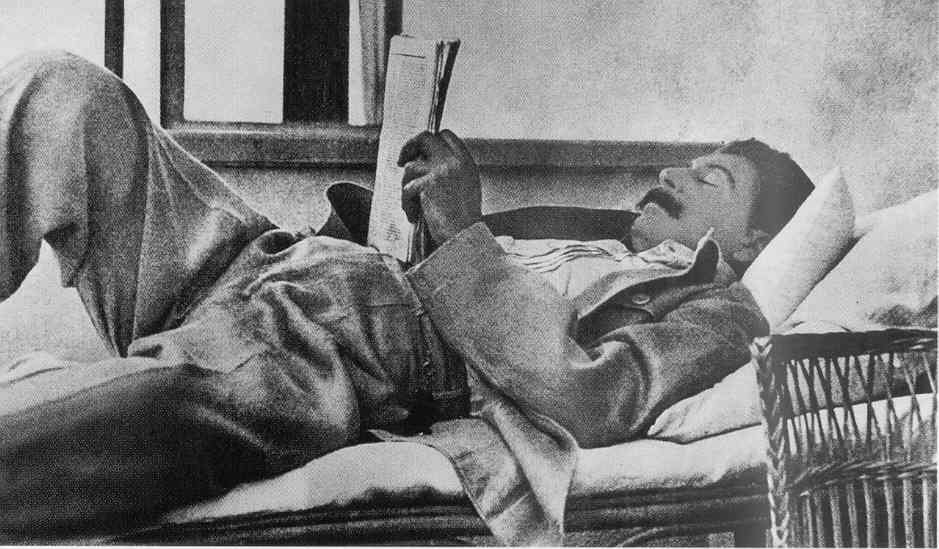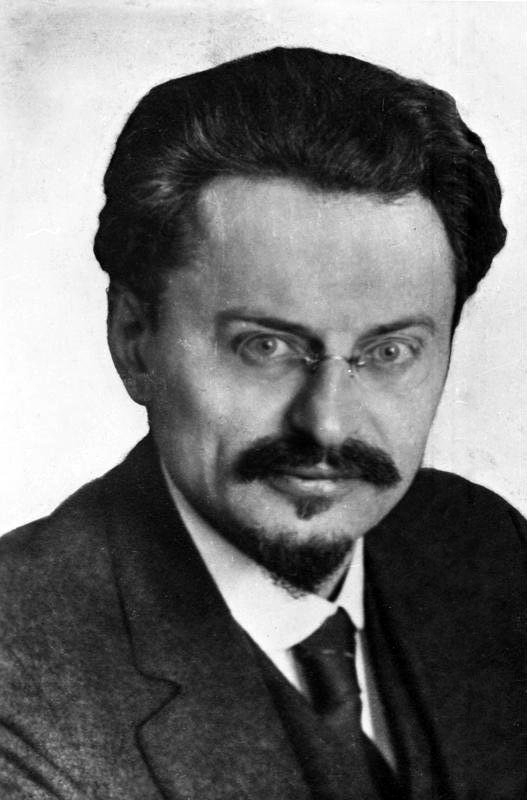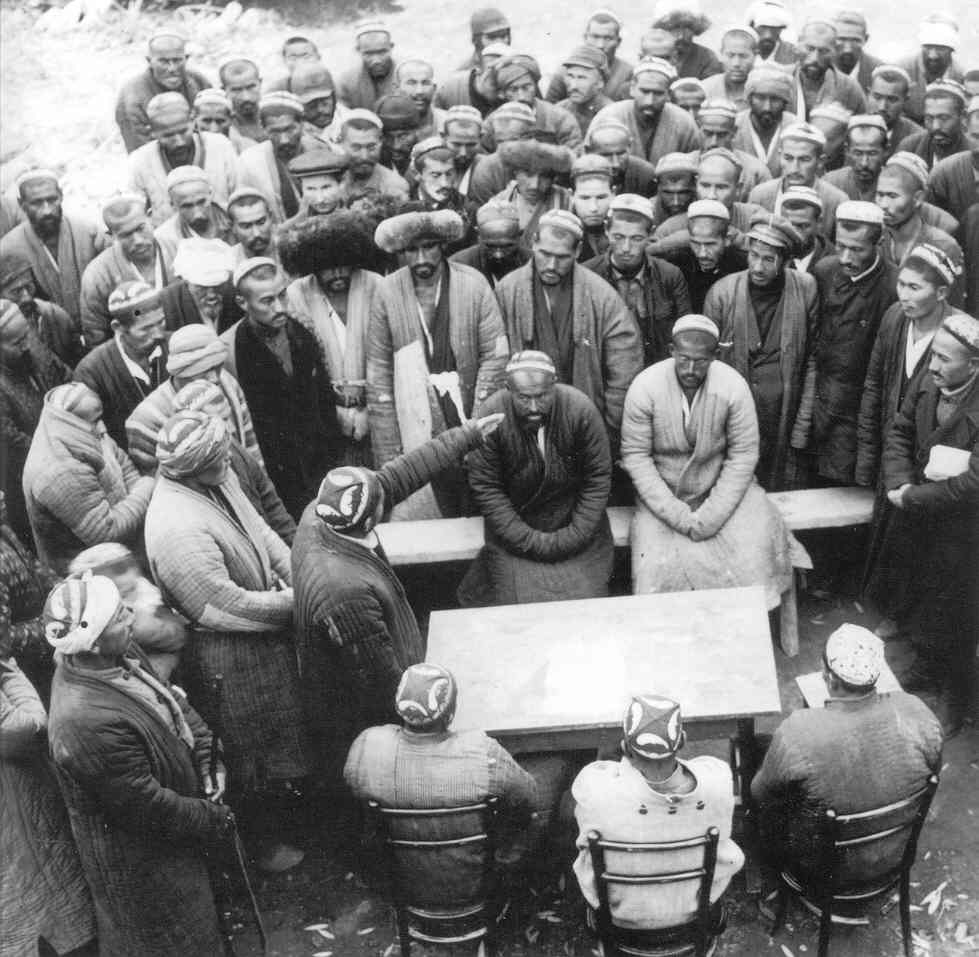15. DEPRESSION ... AND MORE DICTATORSHIP
(THE 1930s)


STALIN'S SOVIET RUSSIA
 Stalin's rise to power
Stalin's rise to power
 Stalin's forced industrialization of
Stalin's forced industrialization of
Russia
 The Second and Third Five-Year Plans
The Second and Third Five-Year Plans
The textual material on page below is drawn directly from my work
A Moral History of Western Society © 2024, Volume Two, pages 139-143.
STALIN'S RISE TO POWER |
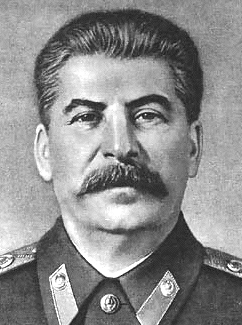 Working behind the scenes was the mysterious
Stalin, who during the Revolution had been assigned the less glorious
task of overseeing personnel issues (selection and advancement of party
members) of the Party hierarchy. But Stalin had been using
his position to place and promote individuals presumably loyal to
himself personally – thereby building up a personal power base within
the Party, a development to which the Bolshevik intellectuals directing
the Party at its highest levels had not been paying much attention. Working behind the scenes was the mysterious
Stalin, who during the Revolution had been assigned the less glorious
task of overseeing personnel issues (selection and advancement of party
members) of the Party hierarchy. But Stalin had been using
his position to place and promote individuals presumably loyal to
himself personally – thereby building up a personal power base within
the Party, a development to which the Bolshevik intellectuals directing
the Party at its highest levels had not been paying much attention.At Lenin’s death in 1924 the party leaders expected Trotsky to take over Lenin’s role. Lenin had even earlier given indication that he clearly favored Trotsky over Stalin (whom he did not trust), the latter who had clearly been at work building his own power base in the party. When a sick Trotsky failed to make Lenin’s funeral Stalin turned this into the opportunity Stalin had been preparing for to attack Trotsky, calling on all his supporters to back him in his move. At the beginning of 1925 Stalin had Trotsky removed from his position at the head of the Red Army. Trotsky’s complete fall after that happened quickly. Stalin intimidated his fellow Bolsheviks into agreeing to the need to focus on ‘revolution in one country’ (Russia), to focus only on the rapid industrialization of Russia (at the expense of the Russian countryside and its people), and to oust Trotsky whose internationalism threatened the security of the revolution in Russia. Thus in 1927 Trotsky and his supporters were forced from the party ... and in 1928 Trotsky was forced into exile. Stalin now held total control over the Community Party and the Soviet State. |
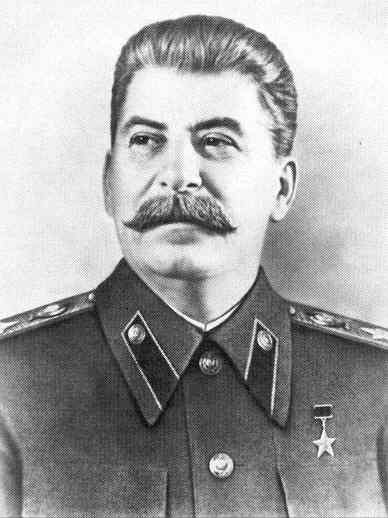
Library of Congress
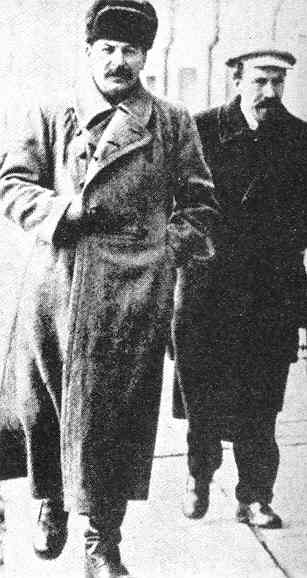
Joseph Stalin and Aleksei Rykov
(one of the Bolsheviks he deposed to become absolute dictator in Russia by 1927)
Deutsches Bundesarchiv
STALIN'S FORCED INDUSTRIALIZATION OF RUSSIA |
| Already
Lenin’s idea of developing Russian or Soviet industry under tightly
controlled private plus state capitalism had begun to be put aside as
private producers were placed ever heavy restrictions ... resulting in
hundreds of thousands of bankruptcies. Even local farmers who had
begun to make a success of farming as a business (the Kulaks) were
dragged before courts and accused of anti-revolutionary activity... and
not only had their lands confiscated but multitudes were sent off to
exile in Siberia. Then with the introduction of his first Five Year Plan (1928-1932), Stalin took complete control of the wealth, the productivity, the very life of Russia – and completely reoriented its culture to his industrial agenda. The plan was devoted entirely to the creation and management of the huge state-owned collective farms and the state-run heavy industries. Missing was any focus on consumer goods for the people themselves. Thus Russia's private industries and extensive farmlands were nationalized – put under the direction of Stalin's bureaucrats … and anyone resisting this move was arrested and sent off to a Siberian work camp for his "anti-revolutionary" activity. The results of the plan were mixed. Iron and steel production was increased greatly … and coal, oil and electrical production came close to meeting Stalin's goals. But other areas, such as in textile manufacture, fell far short of his goals. And agricultural production was a total disaster … producing mass starvation in an economy once based largely on agriculture. This was because the farmers naturally resisted having their lands turned over to and run as new "collectives" by Soviet authorities – for instance, farmers slaughtering their animals rather than turning them over to their new Soviet authorities. But in any case, the Russian farmer now ranked simply as another common laborer in Stalin's "workers' paradise." But it was no paradise … with farming families unable even to feed their own families from the production required of them on their former lands. Their production was now intended to feed the growing industrial work force … not the farmers themselves. Tragically, any family that did not look as if it was starving obviously was guilty of holding back part of its production to feed itself (the crime of "hoarding") … and its members were arrested and sent off to one of Stalin's Siberian work camps … where they died – on their way there or soon thereafter. Thus possibly 12 million farmers and their families died from starvation or industrial slavery in the early 1930s … in order to make way for the country’s transition from traditional agriculture to modern industry. |
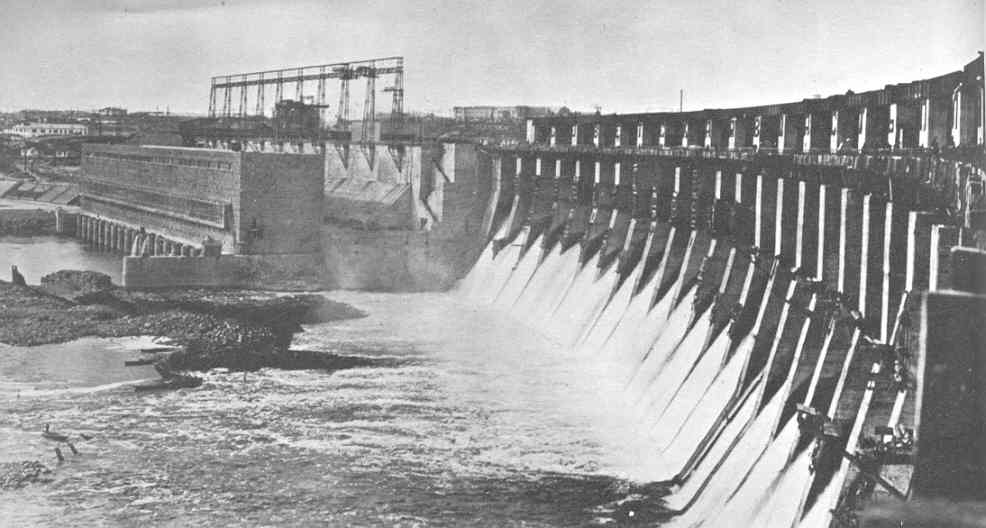
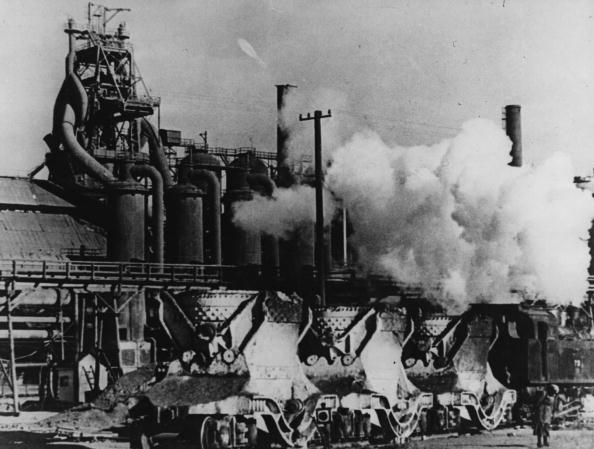
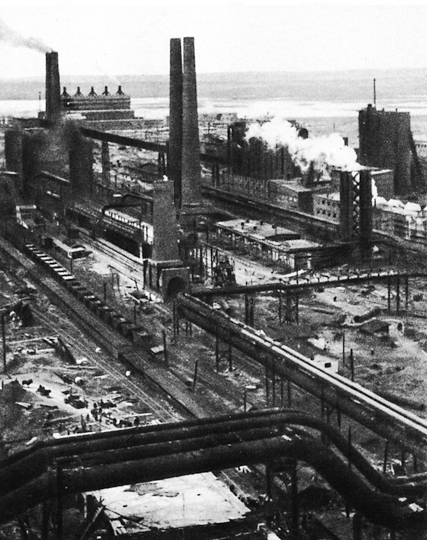
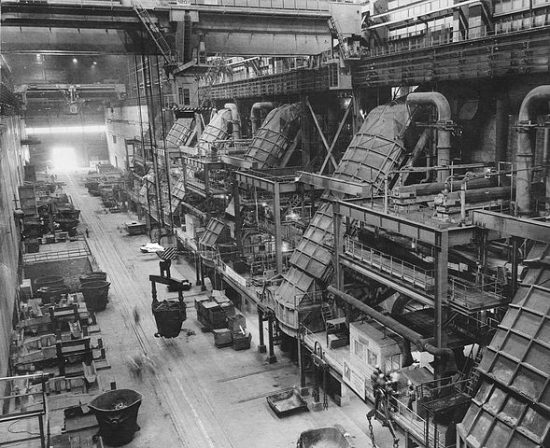
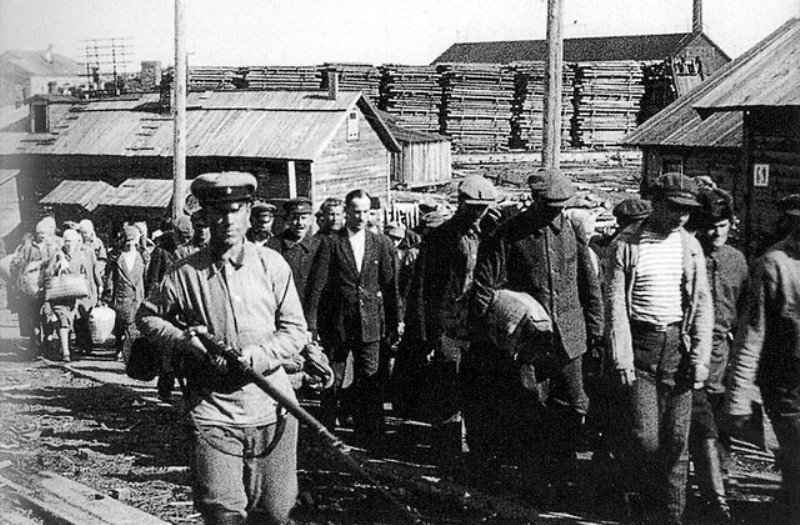
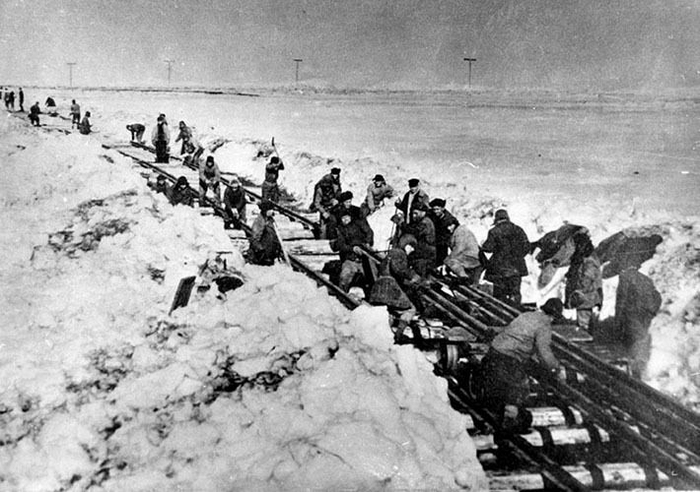
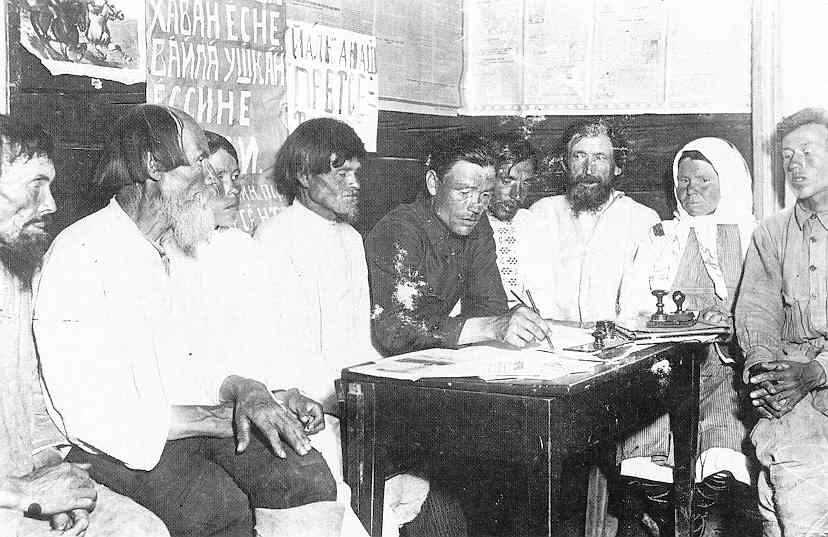
A Communist party official
instructing peasants on collectivization
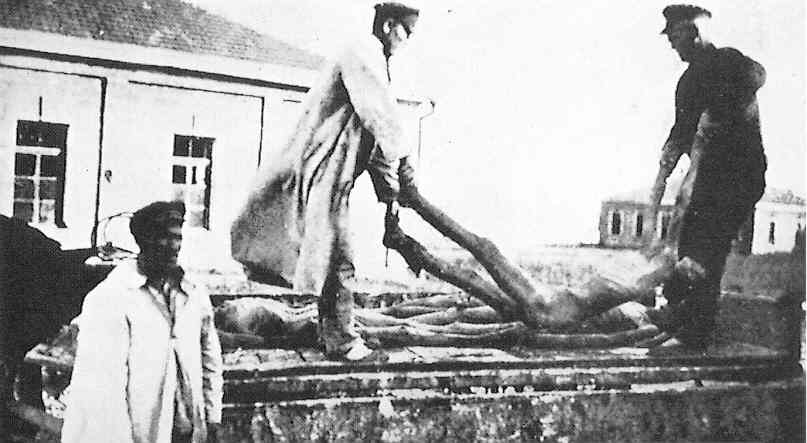
Ukrainians who starved during
the forced collectivization – 1932
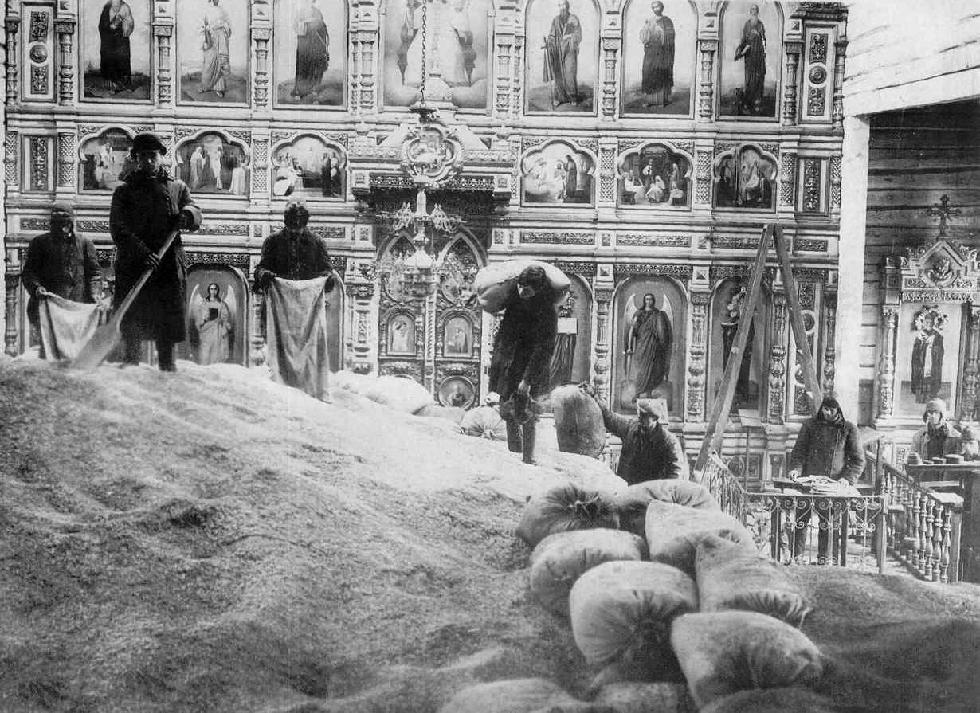
Russian church in Petrovsky
being used as a grainary – 1930
STALIN'S MURDEROUS SIDE |
| Actually
nothing like Marx’s Communist utopia was going on in Stalin’s
supposedly "Communist" Russia. The state was hardly withering
away. Under Stalin, it had expanded its powers until virtually
nothing at all went on in the Soviet Union that did not come at least
indirectly under the tight grip of Stalin’s police state.
Intellectual idealists outside Russia were unable to see the horrible
price being paid by the Soviet farmer to enable this amazing industrial
building program to go forward in the Soviet Union (since Stalin had
terrorized the nation into silence about this part of his great
"achievements"). Farming families were forced to hand over their fields and herds to Soviet authorities as part of Stalin’s policy of ‘collectivizing’ Soviet agriculture. At this point farmers in this Soviet ‘workers paradise’ were considered as simply fellow workers for the Soviet state, much like the workers. in the factories, mines and other industrial operations. But Stalin’s treatment of the farmer was brutal in the extreme. He intended to transfer the national wealth of Russia from the countryside to his new industrial cities. And so he simply confiscated the wealth of the countryside to finance his industrial programs. "Hoarding" of food production was a crime punishable by death. And if a farmer and his family looked moderately healthy, they did so because they were ‘hoarding,’ that is, holding back part of their harvest for themselves. That was highly illegal. Thus many farming families simply took the route of slow starvation. Many others were sent to Siberian work camps for actively resisting this forced collectivization – where they died either along the way or within a few years of arriving at these work camps. In the process possibly as many as 12 million farmers died to make way for the country’s transition from agriculture to modern industry in the early 1930s. |
THE GRAND SOVIET ILLUSION |
| Ironically,
Stalin’s Russia of the early 1930s carefully presented to the outside
world a marvelous picture of rapid industrial development at a time
when the Western world was caught in a deep economic depression.
Whereas high unemployment rates and idle factories presented a picture
of failed ‘capitalism’ in the West, Russia’s socialist or communist
experiment seemed to stand out in glorious contrast as a grand success:
hydroelectric dams going up across many broad Russian rivers to bring
huge amounts of electricity to Russian society, steel plants rising
everywhere to produce the steel needed for trucks, tractors, etc.;
urban housing for the Russian worker going up everywhere,
etc. Communism seemed to be proving itself under Stalin’s
masterful direction. But Stalin's Communism had nothing to do with Marx's Communism, instead being simply a form of state capitalism. Stalin's state now owned everything ... and the workers themselves had no say in how their "worker's paradise" took shape – or the benefits they themselves would draw from the new system. This was political, economic and social dictatorship, pure and simple. Sadly, many Western social philosophers were taken in by the picture that Stalin carefully presented ... and found themselves advocating eagerly for a similar policy of Communism – or at least its close cousin Socialism – to be instituted in their own countries. Many, of course, would one day come to regret deeply their having been so deceived … for having identified themselves so closely with Communism in their writings and political activity. But even more tragic, young Westerners – hearing from their intellectual mentors and teachers in America and in Europe of the glories of Stalin's Communism – traveled to Russia to see firsthand the Soviet wonder ... and stumbled upon what they were not supposed to see: the huge suffering that much of the country was experiencing in order to make Stalin’s dream possible. Few of these idealists ever made it back alive to the West, but simply disappeared into Siberia in one or another of Stalin’s gulags (concentration camps) where they died miserable deaths. |
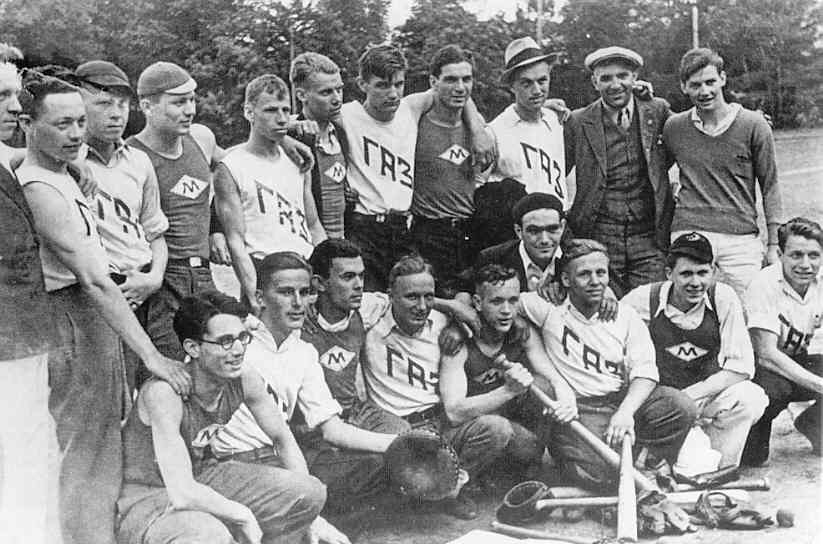
American expatriates who moved to the Russian Socialist "utopia" – 1932. Stalin, who trusted no one, "liquidated" even these enthusiastic dreamers from America. They were eventually sent off to Stalin's gulags (prison camps). None of them would ever make it back alive to America.
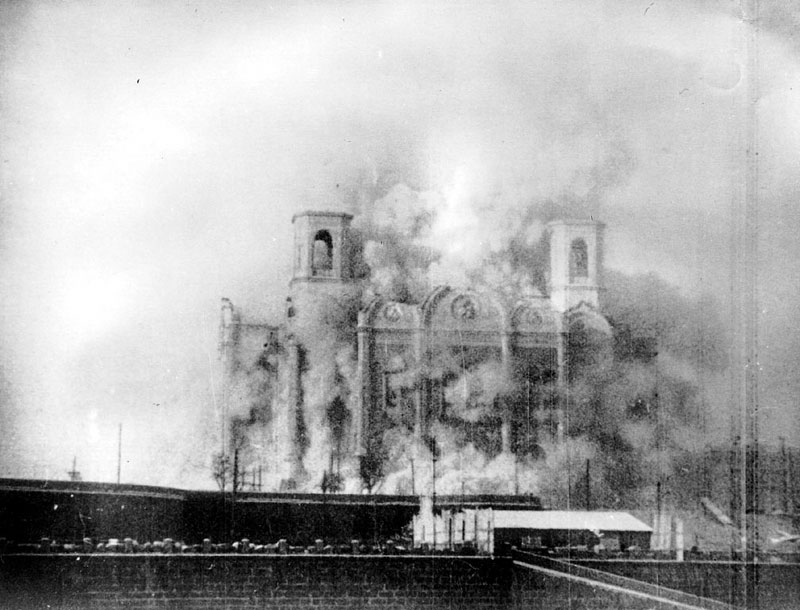
THE SECOND AND THIRD FIVE-YEAR PLANS |
STALIN'S PURGES (1936-1938) |
| Less
wise was Stalin’s decision in the second half of the 1930s to cleanse
the party, the state and the military of personnel that Stalin and his
body of inspectors considered to be less than fully trustworthy.
Discipline had been the word of the day since even Lenin, who took the
attitude that the Communist Party must operate much like a military
organization ... under total control by a hierarchy of officers
reaching all the way to the top (the Politburo of the Central
Committee), orders coming from the top to be carried out without
hesitation by those lower down on the chain of command. Any
resistance to such authority would put the revolution in peril and thus
could not be tolerated. This had been Stalin’s major function in the early days of the Revolution: to maintain party discipline, elevating those of proven loyalty and removing those who did not measure up. Of course for Stalin the matter of loyalty was soon perceived as a personal matter as much as an party matter ... and eventually the personal aspect came to trump all other considerations. Total loyalty to Stalin was what loyalty to the party, to the state and to the military soon came to mean in Stalin’s paranoid thinking. Quickly eliminated (no questions asked) was anyone suspected of even the slightest disloyalty by Stalin and his personal police. During the "Great Purge" (the Yezhovshchina or "Period of Yezhov")1 elimination extended even to the very highest circles of the party: of the seventy-one members of the party’s Executive Committee in 1934, only twenty-one were still in power four years later; nine had been shot and the others subjected to various forms of punishment. Among those shot were former "heros of the Revolution" such as Zinoviev, Kamenev, Bukharin and Marshal Tukhachevski ... most of them accused on the ultimate sin of "Trotskyism." Of the original members of the 1917 Politburo, only Stalin remained in power (Trotsky had fled to Mexico, the others had been shot). Of other members added to the Politburo since 1917 only two (Molotov and Kalinin) were still alive in 1938. Stalin’s purge or reign of terror was compounded by the fact that local officials took up the cause for Stalin in attacking "anti-party" locals, in order to prove their slavish loyalty to Stalin. Consequently, between Stalin’s own purges, and the purges of those acting in his name (many of whom themselves ironically would fall to the Stalinist purge), hundreds of thousands of party and state officials, plus countless ordinary workers and peasants, were eliminated. Writers, artists, and scholars also suffered heavily as a segment of Soviet society, thousands being carted off to gulags where most would die miserable deaths. Independent farmers (kulaks) who had not joined the collectives were executed in the hundreds of thousands or sent off to the gulags also in hundreds of thousands. And perhaps a quarter of a million of non-Russian minorities such as the Poles and the Crimean Tatars suffered a similar fate simply for the crime of being non-Russian. Political chaos would result, especially during the period from September 1936 to August 1938 when Nikolai Yezhov was head of the NKVD ... and the purges, banishments to the gulags, and the executions reached their height. The disarray would extend to the military as well ... very bad timing for Russia’s military as the war clouds drew darker in Europe. The vast majority of top generals, nearly all of the field commanders, admirals, and corps and division commanders were purged ... plus nearly all of the political commissars (whose job it was to keep a close eye on the military in order to protect its proper ideological character) were removed from command. Thousands of other officers were removed from command ... though perhaps as many as a third of them were allowed to return to command after the Germans attacked Russia in 1941. As paranoid as Stalin was, it was dangerous to be around him ... even to be too successful at whatever you did, as it would set off suspicions in the mind of Stalin that you might willingly or even inadvertently provide a rallying point for those who wanted to see Stalin gone. At this point no one dared to even think to oppose Stalin, even on the smallest point or issue. This would of course be a danger for Russia ... in that it was too dangerous to try to bring any thoughts or opinions or even news (good or bad) that Stalin would be sure to dislike. 1Named after Nikolai Yezhov, who headed up Stalin's secret police or NKVD … who ironically was himself eliminated by Stalin in the summer of 1938 – when Stalin was ready to bring the purges to an end. Sergei Kirov, Leningrad
party leader, and Stalin, in 1934. Kirov's murder by a troubled individual in
December of 1934 became the excuse Stalin used
to begin to purge the Party of his political
opponents (real and imagined)
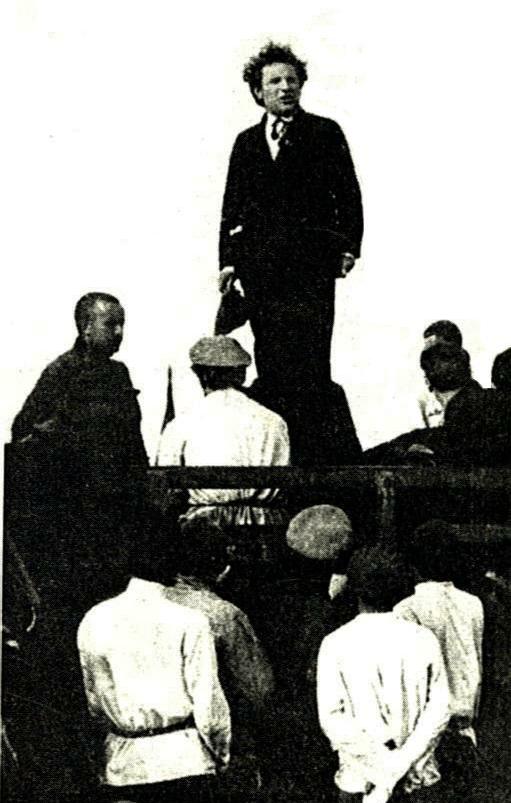
Grigory Zinoviev
speaking. Zinoviev, who was executed
on Stalin's orders after a show trial, was once one of the most powerful and well-known
leaders of the Soviet Communist party. It was his execution in 1936 that began the period of the Great Purge 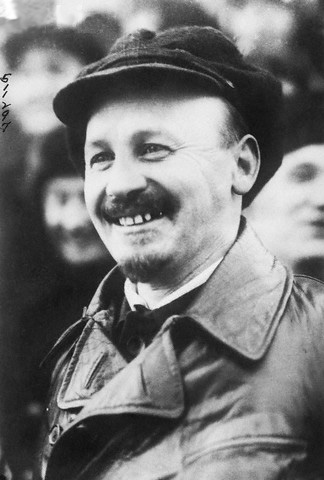
Nikolai Bukharin in 1929 – a leading member of the CPSU Central Committee (1917-1937) ... and executed after a Stalinist show trial in March of 1938.
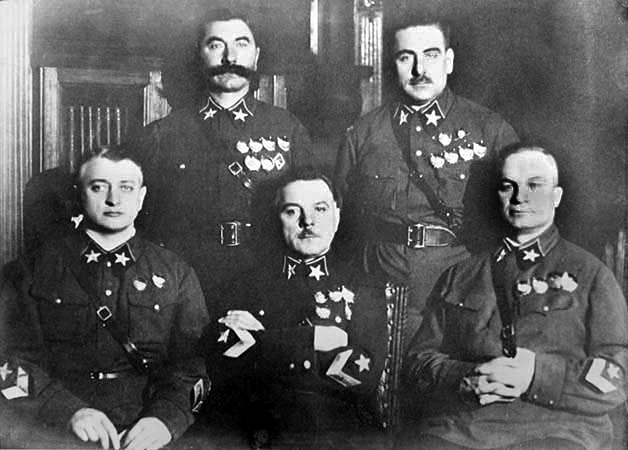
The first five Marshals of the Soviet Union in November, 1935. (l-r): Mikhail Tukhachevsky, Semyon Budyonny, Kliment Voroshilov, Vasily Blyukher, and Aleksandr Yegorov. Only Voroshilov and Budyonny survived the Great Purge. 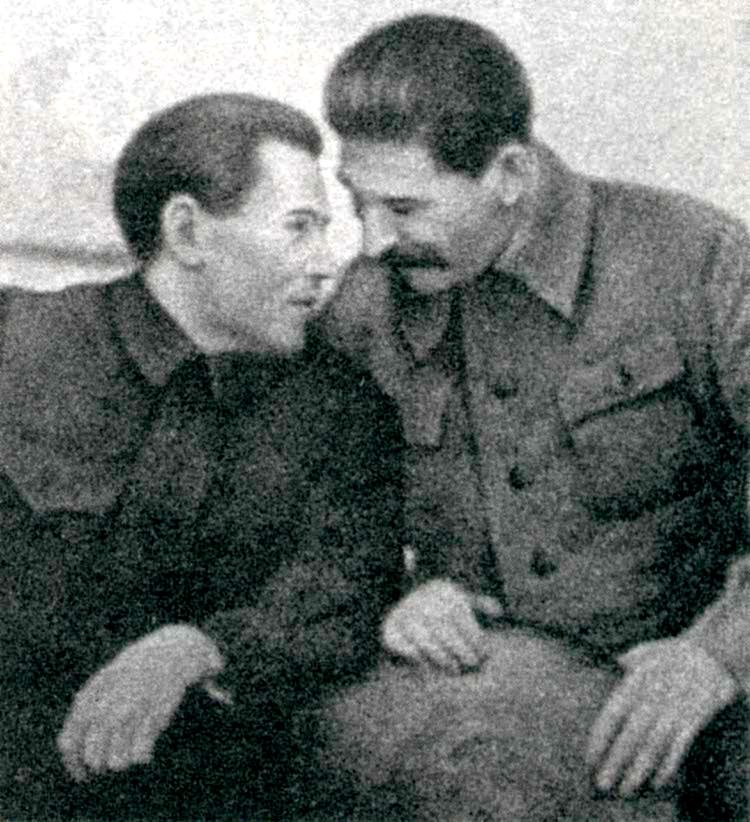
Stalin and NKVD head Nikolai
Yezhov conferring together - ca. 1936-1937. Yezhov would was given the
responsibilty of uncovering and bringing to "justice" any who might be guilty of "unorthodoxy" (meaning: of less than total, slavish loyalty to the person of Stalin himself.) Arrest, torture,
and forced confessions were the techniques he used
to purge the Party and Red Army of "Fascist Enemies of the
People." 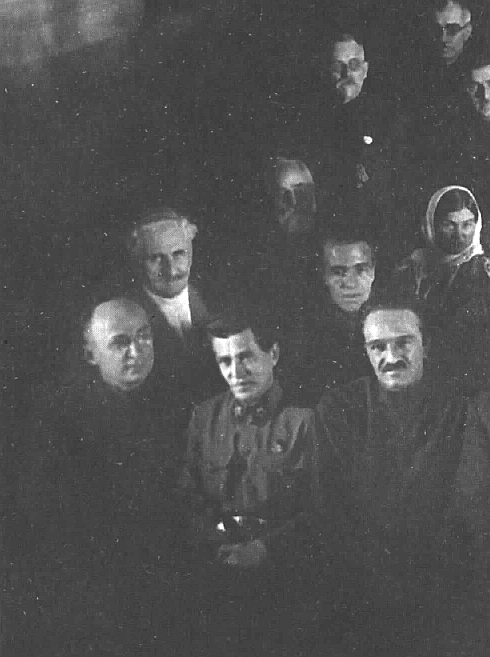
Lavrenty Beria (who would
soon replace Yezhov), Nikolai Ivanovich Yezhov and
Anastas Ivanovich Mikoyan on a reception of delegates
from different parts
of the USSR in September 1938. After having executed nearly
700,000 of the 1.3 million party members and army officers, Yezhov
had arrested, Yezhov had become too powerful
for Stalin's personal comfort.
In 1939 he was dismissed from power,
then arrested, then in early 1940 tried
and executed. 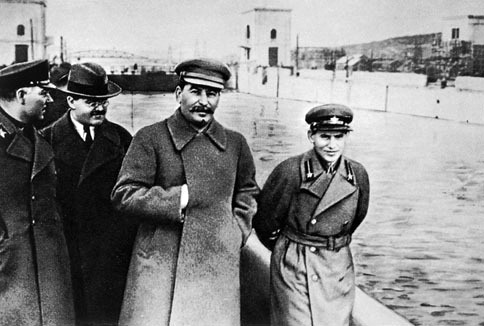 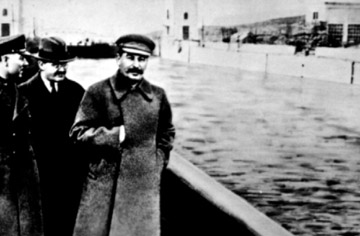
Stalin, Nikolai Yezhov and
Vyacheslav Molotov at the shore of the Moskva-Volga-Channel. After Yezhov was arrested
in 1939 and executed in 1940 he vanished between 1940-1990 from this picture
as well. The later version was altered by censors, removing all trace of Yezhov's presence ... even existence. Although Stalin succeeded in chasing his political rival Trotsky from Russia, highly paranoid Stalin never relaxed as long as Trotsky still lived on – anywhere. 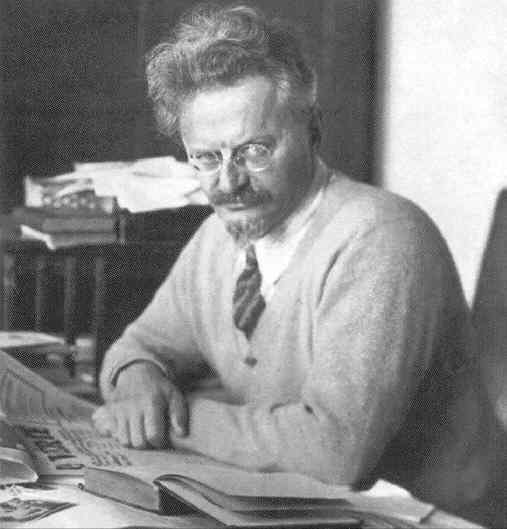
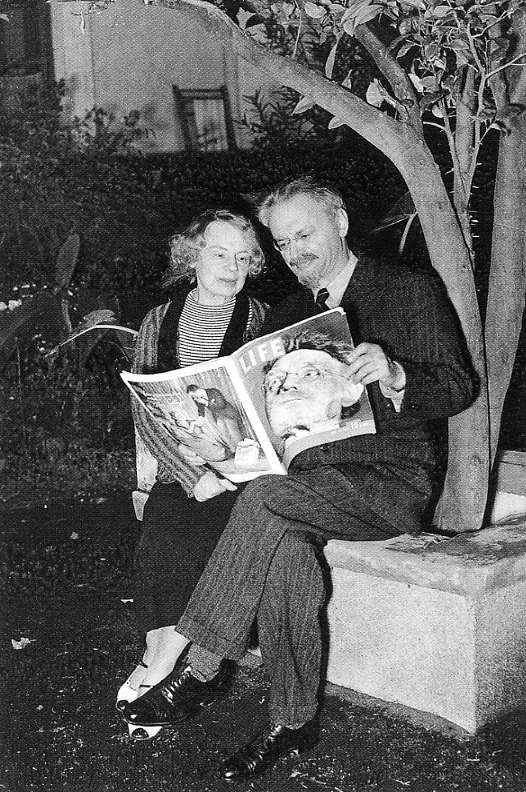
Leon Trotsky (58) and his
wife Natalia in refuge in Mexico City. In 1940 he was
finally
assassinated
in Mexico City by a Stalinist agent with an ice pick  Go on to the next section: Hitler's Germany
 |



